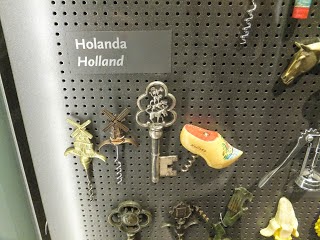I am going to re-use a post that I published in an old travel blog. A few months ago I was fortunate to visit the Museum of Wine Culture of Bodegas Vivanco, located in Briones , a village of 856 inhabitants, located in the Rioja Alta, known for its wines and medieval market.

The museum, a private initiative, was created by the Vivanco family after many years of work and assembly of works of art and wine-related instruments. They have managed to create the largest Museum of Wine Culture in Europe, and it has been named by UNESCO as the best wine museum in the world, the most complete.
I made the visit with an invitation to a fairly large group of people, the visit begins with an introductory video, where Pedro Vivanco appears projected, explaining the entire process of creating the museum, while impressive aerial images of La Rioja are projected, focusing on the landscapes of vineyards.
Then we passed to the first of the five rooms, it is the room of the wine culture and its evolution throughout history (from Roman times until now), we can observe different farm tools that have changed over the centuries.


In the next room, an explanation of the use of barrels is done, with an explanatory video in the center of the room which shows a craftsman making a barrel; plus information about the different types of barrels (French oak or American oak), and how they influence the wines.
Attention to the use of different types of bottles for different wines (with a video that represents the traditional way of producing them), and the evolution of cork is also provided, from traditional to modern corks.

We now turn to the third room, in my opinion one of the most spectacular rooms of the museum, we find different instruments involved in the production of wine (there are pieces of different countries), there are also presses from Spain, as Asturias, Castilla and Valencia. There is a space dedicated to the history of wine promotion in Spain (always associated with Spanish customs and traditions), and their traditional way of drinking with wineskins. There are also various objects used to serve wine in taverns and bars. In the first picture, it reflects the way they used to bottle the wine.
In the fourth room, there is a collection of sculptures, paintings, and all kinds of figures related to art, all with motifs of grapes or wine as we see in the following images:
Before moving on to the last room of the museum, we find a viewpoint that connects the museum with the winery in this viewpoint we see an octagonal room full of barrels.
The last room is the largest corks collection of the world, more than 3000 corkscrew.
The visit ends with the previous room, and then there is an access to the bar-restaurant of the museum, where you can go into the garden where there is a playground and where you can see the winery Vivanco, and incredible views of Sierra de Cantabria and vineyards surrounding the complex Vivanco.
To sum up, a great place to learn about the culture and history of wine, not only of La Rioja, of all over the world.
One way to understand the importance and the incredible world of wine, both for experienced wine lovers and for beginners in this world.
Soraya








































